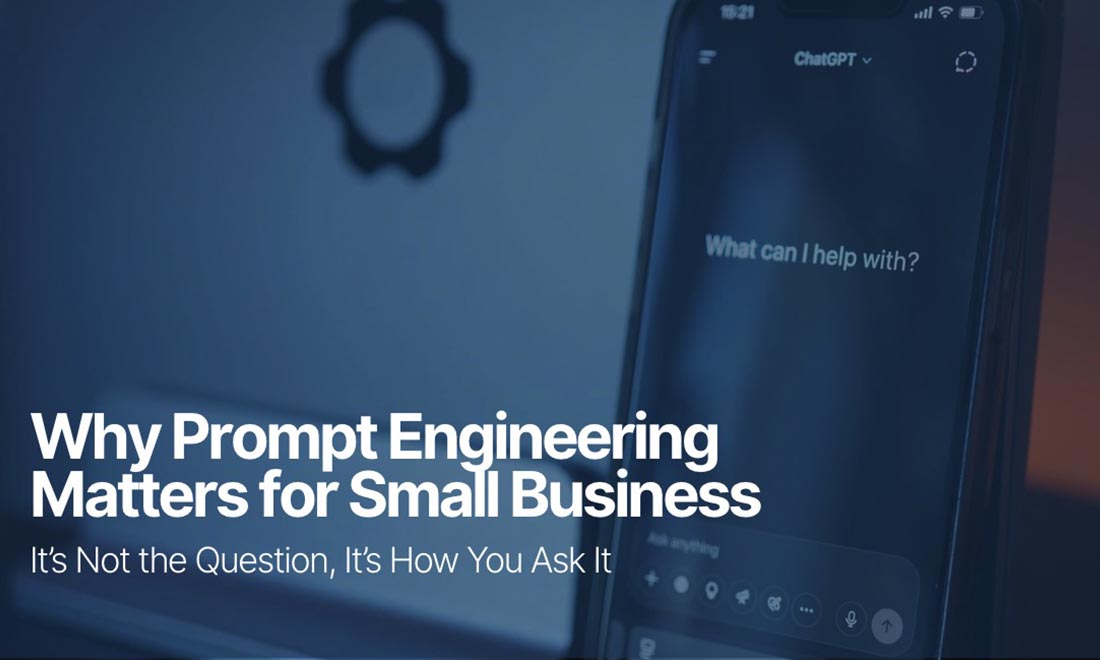It's Not Just the Question, It's How You Ask It: The Essential Power of Prompt Engineering
In today's AI-powered world, tools like ChatGPT and Claude are remarkably capable-but they're not mind-readers. Many users launch into conversations with vague or direct questions and are disappointed when the responses miss the mark. Why? Because LLMs (Large Language Models) don't know your business, challenges, or context unless you tell them.
Why Prompt Engineering Matters
Prompt engineering is the art of crafting inputs that give language models both direction and purpose. It's not just "What is X?" but "Here's who I'm targeting, what I need, and the style I want." For small businesses in particular, effective prompt writing can cut through confusion, boost productivity, and unlock AI's true potential.
1. Be Specific About Your Context
Start by priming the model with your backstory:
- “I'm a small-business owner in digital marketing aiming to increase client engagement.”
- “I run a local café and need seasonal promotion ideas without blowing my budget.”
This helps the AI adopt a voice and approach tailored to your needs.
2. Define the Role and Scope
Tell the model who it should pretend to be:
- “You are a seasoned brand strategist.”
- “You are a professional copywriter who writes in a friendly, approachable tone.”
Then set the task:
- “Provide me with five taglines that highlight family-friendly and eco-conscious values.”
- “Draft an email sequence to re-engage past customers.”
3. Give Examples of Desired Output
Show the AI what success looks like:
“Here's an example of a catchy tagline: 'Sip Life. Sustainably.'”
This guidance helps shape tone, length, and cadence.
4. Set Constraints and Format
Outline your practical needs:
- “Use simple English: no more than two sentences per tagline.”
- “Give bullet-point lists, 3-5 items each.”
- “Include a call-to-action in each email draft.”
5. Iterate and Refine
Prompt engineering isn't a one-shot deal. Feed the output back in:
- “Can you make the tone more playful?”
- “Shorten the email sequence to three messages.”
- “Add a personal anecdote to align with my brand story.”
This iterative loop ensures continuous improvement.
Case Study: A Café's Prompt Makeover
Before: “Give me marketing ideas for my café.”
Result? Generic and uninspiring.
After:
“You are a seasoned local marketing consultant. I run a small coastal café with limited budget. Please suggest three weekend-only promotions appealing to tourists and families, including quick social-media angles and one budget-friendly newsletter blurb.”
Result: Focused, actionable ideas like “Seaside Sundae Sundays with a postcard-photo contest” and ready-to-use copy.
Why Small Businesses Should Care
For small teams, time is money and misfires cost both. Prompt engineering turns AI into a precision tool:
- Faster results - No floundering around vague answers.
- Higher relevance - Insights that align with your brand, voice, and audience.
- Scalability - Reusable templates that grow with your business.
Common Prompt Mistakes to Avoid
- One-line queries: “Write me a Facebook post.” Too vague, supply context first.
- No target audience: Not knowing who the post speaks to causes watered-down language.
- No style guidance: Is it playful? Formal? Technical?
Practical Prompt Template
Use this structure and tweak to your needs:
I am [your role] at [business/industry].
You are [your desired AI role and tone].
My goal: [what you want to achieve].
My audience: [who they'll read it].
Format: [email/social/bullet points].
Constraints: [length/keywords/call to actions].
Examples: [paste 1-2 outputs you like].
Task: [your specific request].
When to Go Deeper with Context
For more complex tasks, like building a content calendar, writing a whitepaper outline, or developing marketing strategy layer in:
- Brand values and mission
- Key products or services
- Audience personas and pain points
- Competitor positioning or market insights
Measuring Prompt Success
Track how AI improves your business outcomes:
- Time saved per task
- Response quality and relevance
- Engagement metrics on outputs (e.g., social reactions, click-throughs)
So, in my view here is how we get it right
AI will only succeed if you guide it well. Prompt engineering is more than a buzzword, it's the bridge between AI's raw power and small businesses' real needs.
By investing a little time into crafting precise, context-rich prompts, you unlock quicker wins, higher-quality output, and tools that grow with your vision. Remember: “It's not about the question, it's how you ask it.”

